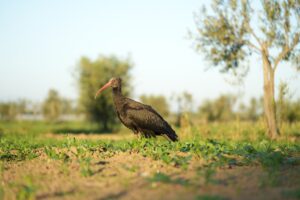Northern bald ibis
With its iridescent green-black plumage and naked red head, the northern bald ibis, Geronticus eremita, is one of the most bizarre birds in the world. The long feathers framing the face serve as a mood indicator, the birds raising them into a sort of crest when excited. Males and females do not differ in plumage, but young birds are easily recognized by the lack of a tuft on their gray feathered head.
Northern bald ibises hunt insect larvae, earthworms, and other invertebrates on meadows and short-grass pastures, using the long, slender, decurved bill to find and capture their prey.
Historically, colonies of this very social bird contained as many as several thousand individuals. Bald ibises are seasonally monogamous, though some pairs stay together for many years; mated birds greet each other by spreading the crest and bowing to each other with a slurping “chrrupp” call. Nests are built in crannies in steep rock faces.
This ibis traditionally left the breeding grounds in Switzerland, Austria, Germany, Italy, Spain, Hungary, and Greece in autumn for wintering areas in Mauritania, Senegal, Ethiopia, and Eritrea. Juveniles followed the experienced birds and learned the migratory route. Today, most wild ibises no longer migrate, but are sedentary, remaining in one place all year.
Today, the northern bald ibis is classified as Critically Endangered by the IUCN, and inhabits only a tiny fraction of its original range. Human persecution began no later than the 16th century, when ibis, especially young birds, were considered a delicacy; by the early 17th century, the ibis had disappeared from Europe, leaving only a single sedentary population on Morocco’s Atlantic coast, now numbering about 600 individuals .
Thanks to a project of EU LIFE, waldrapp.eu/en, a migratory population of northern bald ibises was re-established in Europe between 2014 and 2019. Coordinated by the Austrian Förderverein Waldrappteam, the project removed two-week-old zoo-bred nestlings from their parents and imprinted them on humans. In late summer, the juveniles were then taught to follow a motorized ultralight aircraft on the 600-mile journey to Tuscany. After arriving in the wintering area, the birds were placed in an aviary and cared for by their human “foster parents” and an Italian WWF Oasi team. After a few weeks, the birds were released in groups of five to ten; many were fitted with GPS transmitters for tracking their movements and behavior. Most of the birds remained in the wintering area, migrating only sporadically until attaining sexual maturity.
As of 2019, there were three breeding colonies, totaling 71 pairs, north of the Alps, all wintering in Tuscany’s Maremma. Every spring, some birds, having learned the migratory route, now return to the breeding areas on their own. The project has supplement this work with an information campaign to discourage illegal hunting, which remains the principal threat to the survival of this species.
A second LIFE project has now been approved to develop the population to a level at which it is entirely self-sustaining. By the end of 2028, more than 260 northern bald ibises are expected to migrate between the Alps and Tuscany. In addition to the colonies in Germany and Austria, others will be established in Switzerland and northern Italy. The WWF Oasi Laguna di Orbetello in Maremma will continue to be the common wintering ground for birds from all these colonies.
